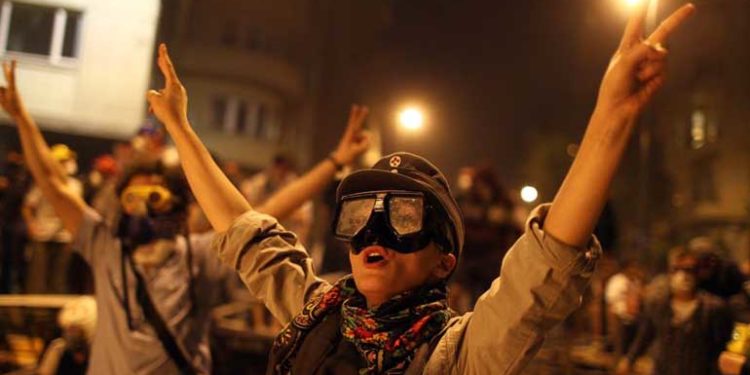In Turkey’s recent history, “Gezi” is the most important resistance movement triggered by environmental questions.
The Beginning
On a politically tense background, the last drop overfills the cup, and this drop is Gezi.
From City Hall, the government announces an urban project for Taksim. The problem is, among other things, that the project involves the destruction of the Gezi, one of the rare parks in an urban setting. One of Istanbul’s rare lungs.
The recent urbanization project planned to build a replica of the Halil Pasa casern, as part of Turkey’s Ottoman cultural heritage. The purpose of this casern would be: a shopping centre.
Along with all the other corruption within the government, the people had had enough.
In Gezi Park, a handful of people organise themselves and begin to speak out. Of course, the media holds on to the stance of this being an ecological resistance only, rather than a political outcry. This continues for a long time until they can no longer deny the fact something important is going on.
Mobilization begins on May 27, 2013, with a group rally in Gezi Park to stop machinery brought in to cut down the trees. Gezi becomes a protected area by its occupiers.
By the beginning of June, crowds start filling streets in large and small towns. The demonstrators chant slogans, carry signs, carnations at times. They are peaceful. The governmental response is disproportionality violent and causes thousands of injuries, including several instances of severe brain trauma, and mutilations such as the loss of an eye. Five people are killed.
Taksim Square
Gezi Park is next to Taksim Square in Istanbul; the very symbol of cosmopolitan Istanbul – but that’s not all. Taksim Square is the place for all political rallies, the departure point for all demonstrations. The square remains an important point politically, because of the blood that has been shed on its grounds; the most highlighted massacre being May 1st demonstrations, where 36 dead, bloody bodies stained the grounds of Taksim.
Traditional May 1st demonstrations are banned for many years thereafter but have recently resurfaced despite the ban. In Istanbul, Taksim remains the take-off point for any demonstration. And participation grows every year.
The Gezi Community
The ranks grow of the small handful of people near the trees, as people come in the hundreds, then in the thousands. At first, there are a few tents, then a real village. Food, water, and clothing are organised by the protestors; the resources are given for free and divided equally amongst the people.
A citizens’ assembly is constituted and there is a constant debate. The entire movement is peaceful yet powerful. There are families, children, all kinds of people from every socio-cultural strata, occupying the park. And one night, the police charge. Very violently.
The Resistance
The resisters fought back with intelligence, practicality and, most of all, solidarity and a sense of humour. Slogans, signs and tags erupt like fireworks, turning to ridicule the declarations, orders and speeches being delivered with utmost seriousness.
Gezi stops being an environmental protest and emerges into something sacred at this point, where solidarity emerges. In the midst of real struggles and demands, differences die down by themselves. With every attack of the fascist police, prejudice weakens. Hate weakens. Believers, non-believers, conservatives, gays, lesbians, queers, Turks, Kurds, CHP supporters and PKK supporters fight back shoulder to shoulder.
Local shops provide wi-fi codes for communication, the young people film and publish non-stop. Lawyers, doctors, nurses provide their personal number to help the wounded or the arrested. Makeshift infirmaries spring in hotels, in closed parking lots.
During the time, the then Prime Minister talks of small groups, of terribly dangerous terrorists in the streets… For the government, this crowd is nothing but a few vandals. Even a brief look at the politics which surrounds Gezi makes it clear that the resistance is being portrayed as a conflict between believers and nonbelievers as if republican secularism oppressed believers. This was distorted too, religious organisations played their part in the resistance too, along with the individualistic and apolitical youth.
What Happens to the park?
The project is withdrawn, but Taksim Square is covered over with cement. But things aren’t so simple.
After Gezi, several events spark protests. Projects of the presidential White Palace with its one thousand rooms, the project for a third bridge over the Bosphorus, the revelations concerning the corruptions of government members and of those nearest Erdogan, the catastrophes linked to working conditions, contested results at municipal elections where rigging is suspected, the transformation of public schools into Coranic ones, the arrival of the scarf in schools, administrations, the national assembly…Sexist and racist declarations by elected members or Islamo-Conservative personalities encouraging violence against women.
What matters most is this Gezi opens eyes. Where a common identity is still afar, a common unity is demonstrated to be possible. And powerful too.














